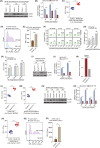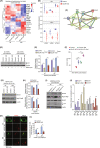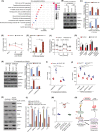NCoR1 controls Mycobacterium tuberculosis growth in myeloid cells by regulating the AMPK-mTOR-TFEB axis
- PMID: 37590294
- PMCID: PMC10465006
- DOI: 10.1371/journal.pbio.3002231
NCoR1 controls Mycobacterium tuberculosis growth in myeloid cells by regulating the AMPK-mTOR-TFEB axis
Abstract
Mycobacterium tuberculosis (Mtb) defends host-mediated killing by repressing the autophagolysosome machinery. For the first time, we report NCoR1 co-repressor as a crucial host factor, controlling Mtb growth in myeloid cells by regulating both autophagosome maturation and lysosome biogenesis. We found that the dynamic expression of NCoR1 is compromised in human peripheral blood mononuclear cells (PBMCs) during active Mtb infection, which is rescued upon prolonged anti-mycobacterial therapy. In addition, a loss of function in myeloid-specific NCoR1 considerably exacerbates the growth of M. tuberculosis in vitro in THP1 differentiated macrophages, ex vivo in bone marrow-derived macrophages (BMDMs), and in vivo in NCoR1MyeKO mice. We showed that NCoR1 depletion controls the AMPK-mTOR-TFEB signalling axis by fine-tuning cellular adenosine triphosphate (ATP) homeostasis, which in turn changes the expression of proteins involved in autophagy and lysosomal biogenesis. Moreover, we also showed that the treatment of NCoR1 depleted cells by Rapamycin, Antimycin-A, or Metformin rescued the TFEB activity and LC3 levels, resulting in enhanced Mtb clearance. Similarly, expressing NCoR1 exogenously rescued the AMPK-mTOR-TFEB signalling axis and Mtb killing. Overall, our data revealed a central role of NCoR1 in Mtb pathogenesis in myeloid cells.
Copyright: © 2023 Biswas et al. This is an open access article distributed under the terms of the Creative Commons Attribution License, which permits unrestricted use, distribution, and reproduction in any medium, provided the original author and source are credited.
Conflict of interest statement
The authors have declared that no competing interests exist
Figures






References
Publication types
MeSH terms
Substances
LinkOut - more resources
Full Text Sources
Molecular Biology Databases
Research Materials
Miscellaneous

